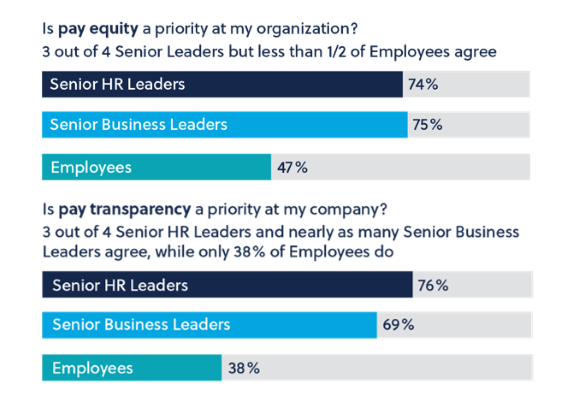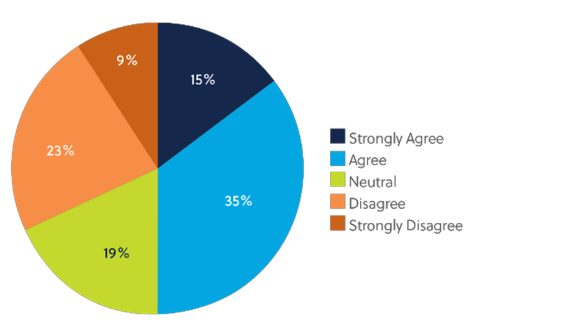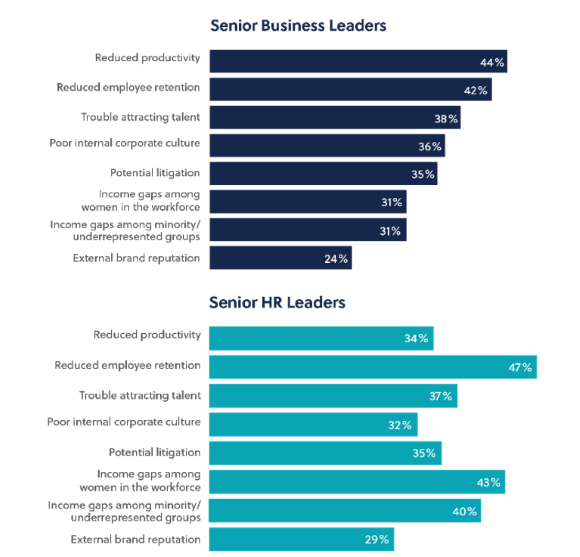Leaders and Workers View Pay Equity Prioritization Differently
Author: Sabina Mehmood, Pay Equity Leader at Brightmine Pay Equity Analytics from HR & Compliance Center
August 29, 2023

For many of us, it may not seem surprising to learn of the disconnect between employees and senior leadership when it comes to pay. But beyond anecdotal speculation of discourse, overwhelmingly, we're starting to see the data that supports this.
While employers may pride themselves on fostering transparent, fair, and equitable workplaces, in execution, employees themselves see much room for improvement. Given the sensitive nature of pay, one may understand why, historically, leaders have shied away from discussing their philosophies and policies openly in the workplace, but the latest in global pay transparency laws have lifted the veil on yet another dimension of the world of inequity.
Earlier this year, HR & Compliance Center sponsored a global research report entitled "2023 Pay Equity and Transparency: Actionable Insights for a Fair Future of Work." The findings assert that leaders and employees have quite different views about the priority their organizations place on achieving that goal.
Pay is certainly not the only area where we may find a disconnect between employees and employers, and it likely will not be the last. However, pay inequities met with lack of transparency and alignment have the power to perpetuate both the opportunity and perception gaps that stand in the way of all aspects of an inclusive workplace.
Equity, Transparency, and the Disconnect
In order for organizations to overcome these challenges and align their priorities, we first must identify where communication and understanding is falling short. Even before this step, we must all agree that there is, in fact, a problem.
And yet our findings assert that employees and employers don't even agree on where they disagree.
Figure 1: The Leader-Employee Gap

SOURCE: Executive Networks and HR & Compliance Center Pay Equity and Transparency Study
Of the HR leaders, business leaders, and employees surveyed in our study, on average, 74.5% of HR and business leaders say that pay equity is a priority and only 47% of employees agree. Similarly, on average, the same three-quarters (72.5%) of leaders say that pay transparency is a priority and just 38% of employees agree.
As we work to compile the data driving change, our findings assert the disconnect begins with a perception gap of priorities when it comes to pay. Beyond priorities, there is also lack of agreement on whether pay inequities exist at all. Only 50% of respondents agree or strongly agree that pay inequities exist in their companies, leaving 50% at odds.
Figure 2: One-Half Say Pay Inequities Exist at Their Organizations
Across all of those surveyed, half strongly agree or agree that pay inequities exist at their companies.

SOURCE: Executive Networks and HR & Compliance Center Pay Equity and Transparency Study
This year marks the 60th anniversary of The Equal Pay Act in the US. In the UK, we're nearing the 10-year mark of the UK Gender Reporting Pay Gap Mandate. Yet, pay equity and transparency, more broadly, remain seemingly out of reach for employees themselves.
While leaders themselves claim pay equity and transparency are a priority at their companies, employees just don't see it.
With global law in place for decades ensuring equal pay and protection against retaliation for discussing pay, and employers claiming meeting employees' expectations is their top priority, it begs the question - why is there such a disconnect?
Unpacking the Employer-Employee Disconnect
There are many components contributing to the employer-employee disconnect. To name three: accountability and ownership of pay equity practices in the organization; frequency, consistency, and agility in the pay equity analyses process; and perhaps chief among these components is a lack of transparency and communication between leaders and those who they lead.
1. The Disconnect When it Comes to Transparency and Communication
As we continue to reinvent the future of work, one constant remains: employees want to be part of an open and honest corporate culture.
Today's employees expect open and honest communication, and yet almost a quarter of employees (22%) say their managers do not have conversations with them about pay. More so, of those managers that do, a mere 12% of employees say those conversations are very effective. Being transparent with employees about how pay is determined appears to be another area of communication failure. While 80% of leaders said they have a good understanding, just slightly more than half (55%) of employees said the same.
Applying pay, policies, and benefits for what we think employees want without listening to the individualized needs of employees themselves, and without regular review and iteration, results in this overwhelming disconnect.
2. The Disconnect When It Comes to Accountability
Like any business priority, a clear owner is critical to hold ourselves accountable for progress. But, when it comes to ownership of pay equity analyses and process implementation, senior HR leaders and business leaders don't agree, setting the tone of misalignment from the top.
According to HR leaders, less than a third (30%) say that pay equity should be owned by the CEO while almost half (45%) of employees say it should be owned by the CEO. This signals that employees expect their organization's top leadership to ensure pay equity and treat it as a priority, while HR leaders may still be viewing equity as more of a compliance activity than a business imperative.
Figure 3: Nearly One-Half of Business Leaders Say the CEO Should Own Pay Equity
Senior HR and business leaders had different views on who should lead pay equity initiatives at their organization.

SOURCE: Executive Networks and HR & Compliance Center Pay Equity and Transparency Study
Employers cannot expect to drive progress towards equity without holding leadership accountable for implementing change. Yet, without a clear owner, how can they expect to hold anyone accountable?
3. The Disconnect When It Comes to Pay Equity Analysis Frequency, Consistency, and Agility
Infrequent analyses may be yet another fundamental contributor to the differences in perception of pay equity across the organization. When employees perceive management as treating pay equity as a one-and-done exercise, it is natural for them to question whether or not equity is a true priority.
Given the weight of importance all leaders to which agree to pay equity analyses, the frequency of analyses leaves much to be desired. Of the 77% of leaders who do conduct pay equity analyses, the study finds inconsistencies in the frequency of analyses. Further limiting agility in adapting policies and practices that sustain progress.
Figure 4: Frequency of Pay Equity Analyses
How often do organizations conduct pay equity analyses? Of the 77% of senior leaders who said their organization conducts analyses, here is what they told us about frequency.

SOURCE: Executive Networks and HR & Compliance Center Pay Equity and Transparency Study
This regular assessment allows for iteration as needed to maintain progress, ensuring pay practices evolve as employees do.
Actions to Overcome the Disconnect
Overcoming the disconnect is not a problem to be solved overnight. Driving action in a meaningful way means addressing both perception and pay gaps one step at a time. As you work to determine the action steps to take as an organization, it is important to be realistic about where you are in the journey and understand the incremental steps that will help us achieve monumental progress.
The following are three actions you may consider as you get started:
Action #1: Coach Leaders to Communicate
Don't assume transparency exists. Ensure leaders have the resources to not only understand your organizations pay philosophy and what factors and skills may determine pay, but also to ensure they are prepared to articulate this to their teams in a safe, respectful environment.
Action #2: Hold Leaders Accountable for Pay Equity
Treat pay equity as the business priority it is, aligning on clear goals and objectives, owners, and measures of success. As with any other business priority, hold all leaders and owners accountable for progress.
Action #3: Maintain an Always-On Approach to Pay Equity
As employee needs evolve, and as the social landscape continues to change, ensure pay equity is not treated as a check-the-box activity. If we treat equity as something we can achieve once, and never revisit, we will never truly find equality. We must remain always-on. Determine a clear, concise pay philosophy, track progress, and be realistic in the steps it will take to overcome inequity.
What the Perception Gap Means for the Future of Work
The one area where perception seems to align is the consequence of pay inequity. Reduced productivity, barriers of talent attraction and retention, and risk of widening gender and racial pay gaps stand as top consequences of inequity for both business leaders and those in HR directly tasked with supporting employees.
Figure 5: The Downside of Inaction on Pay Inequities
We asked senior leaders what they see as the negative consequences of pay inequity.

SOURCE: Executive Networks and HR & Compliance Center Pay Equity and Transparency Study
If the future of work introduces anything, it is the risk of widening gaps as challenges continue to evolve. Reduced productivity, difficulties attaining and maintaining talent, litigation, and brand reputation, are just a few of the many implications pay inequity has on a company's bottom line.
Whether we cite economic, legal, or social challenges, the data asserts there is one thing we must all agree on. Differences in perception and priority stand in the way of and fair and equal future, and the time to act is now.